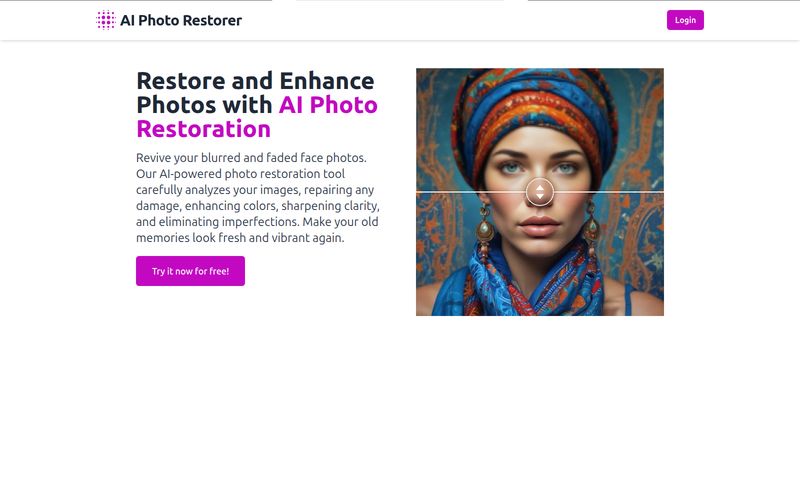The other week I was helping my parents clean out their attic. You know how it goes. It’s a job you put off for years, and it involves more dust than you thought humanly possible. Tucked away in a corner, under a stack of old National Geographics, was a battered shoebox. Inside? A treasure trove. Photos of my grandparents' wedding, a picture of my dad as a toddler looking impossibly serious on a tricycle, my mom in the 70s with a truly spectacular hairdo. All in glorious, faded, black-and-white. Or sepia, really.
And I had that familiar feeling. A mix of nostalgia and curiosity. I wish I could have seen the real color of my grandmother’s dress. I wonder what the world actually looked like that day. For years, the only real option was to find a Photoshop wizard and pay a handsome fee for manual colorization and restoration. But what if I told you there's a tool that can do it in seconds, right from your browser? I’d been hearing whispers in SEO and content circles about AI-powered image tools, and one name kept popping up: ImageColorizer. So, I decided to take it for a spin.
So, What Is ImageColorizer, Really?
Let's get the technical bit out of the way. ImageColorizer isn't just one thing. It's an AI-powered toolkit designed specifically to breathe new life into old photographs. Think of it as a digital restoration workshop. Its main claim to fame is colorizing black-and-white photos, but it’s got a few more tricks up its sleeve. The platform uses trained artificial intelligence models to analyze the data in your monochrome images—the shades, the textures, the context—and then makes an educated guess on the original colors. But it also handles enhancements, repairs scratches, and can even remove unwanted objects from a picture. It’s a pretty ambitious piece of software.
My First Spin: The User Experience
I’m always a bit skeptical of tools that promise “magic.” In my line of work, you see a lot of over-hyped software. So I went to the ImageColorizer site, expecting a clunky interface or a confusing process. I was pleasantly surprised. The design is clean, and you can’t miss the giant “upload” button.
I decided to start with a classic: a slightly creased photo of my great-grandparents from the 1930s. I scanned it, uploaded the file, and held my breath. A few seconds later, two images appeared on my screen: a before and an after. And I gotta say… it was impressive. The AI had turned a faded, monochrome memory into something that felt vibrant and real. The sky was blue, the grass was a plausible shade of green, and the subtle tones on their faces gave them a depth I’d never seen before.

Visit ImageColorizer
It wasn't perfect, mind you. My great-grandfather's tie was a shade of maroon I'm not sure ever existed back then. But it was close. So close it was a little bit spooky. It was less like a computer program and more like collaborating with a talented, if slightly eccentric, artist.
Diving into The Features
Once the initial novelty wore off, I started poking around to see what else it could do. This is where ImageColorizer starts to show its real value beyond just being a cool party trick.
More Than Just a Splash of Color
The colorization is the star of the show. I tested it on about a dozen different photos, from portraits to landscapes. The results are consistently good, especially with outdoor scenes where the AI has clear context clues (sky, trees, etc.). It sometimes struggles with clothing or man-made objects where the original color is a total unknown, but the results are almost always believable. It’s a huge leap from those old, blotchy colorization filters we used to see.
The Digital Fountain of Youth for Photos
For me, the real powerhouse feature is the restoration. We all have those photos—the ones with the creases from being folded in a wallet, the little scratches, the faded spots from sun exposure. ImageColorizer has an “Old Photo Restore” function that acts like digital spackle and polish. It smooths out cracks and tears, sharpens blurry details, and generally cleans up the ravages of time. I ran a picture of my dog from the early 2000s (taken on a terrible digital camera) through the “Enhance” feature, and it sharpened his fur and eyes in a way that was subtle but made a huge difference. This is a game-changer for anyone trying to build a digital family archive.
Wait, It Can Do What Now?
One of the more advanced features is the object remover. You know that classic photobomb situation? Or a random lamp that ruins an otherwise perfect shot? The idea is you can highlight an object and the AI will intelligently fill in the background. My results with this were a bit mixed. On simple backgrounds, it works astonishingly well. On complex, detailed backgrounds, you can sometimes see a bit of a smudge where the object used to be. Still, for a quick fix, it’s an amazing option to have in your back pocket.
The Real Cost of Reviving Memories
Okay, let's talk about the elephant in the room: pricing. Nothing this cool is ever completely free, right? ImageColorizer runs on a credit-based system, which is pretty common for AI services. Here’s a quick breakdown of their plans as of writing this.
| Plan | Price per Month | Key Features |
|---|---|---|
| Free | $0 | 50 credits/month, up to 3000px images, single processing, contains ads. |
| Starter | $3.90 | 500 credits/month, batch processing (up to 8 images), no ads, credits roll over. |
| Premium | $6.90 | 1000 credits/month, all Starter features included. |
| Business | $9.90 | 2000 credits/month, all Starter features included. |
My take? The Free plan is basically a generous trial. It’s perfect for seeing if you like the tool and for restoring a handful of your most cherished photos. The 50 credits a month is enough to get a real feel for it. The Starter plan is the sweet spot for most people. For less than a fancy cup of coffee, you get 500 credits and, importantly, batch processing. If you have that whole shoebox to digitize, this is the one. The Premium and Business plans are for power users, genealogists, or maybe even small businesses who need to restore a lot of historical images for their content marketing.
The Good, The Bad, and The Pixelated
No review is complete without a brutally honest look at what works and what doesn’t. Here’s my breakdown.
What I Absolutely Love
The accessibility is just fantastic. It takes a process that was once highly technical and expensive and puts it in the hands of anyone with an internet connection. The speed is another thing. Seeing a photo transform in under a minute never gets old. And the quality of the restoration, especially for moderately damaged photos, is just top-notch for an automated tool.
"It's like I'm seeing my own history in a new light. It’s not just a technical process; it’s an emotional one. This tool builds a bridge to that."
A Few Things to Keep in Mind
Let's be real, the AI is not a mind reader. The old saying “garbage in, garbage out” applies here. If your original photo is incredibly blurry, tiny, or has huge chunks missing, the AI can only do so much. It will improve it, but it won’t perform a miracle. Also, while the colorization is great, it’s an interpretation. If you need 100% historical accuracy for a museum exhibit, you’ll still want to consult a human expert. This tool is for personal connection, not academic publication.
Who Is ImageColorizer For?
So who should be using this? Honestly, a whole lot of people.
- The Casual Family Historian: Anyone who has that shoebox of photos and wants to share them with family in a new, vibrant way.
- Genealogists: People tracing their family tree can add incredible visual context to their research.
- Social Media Users: Imagine dropping a fully colorized photo of your great-great-grandma on Instagram for a #TBT. It’s a guaranteed conversation starter.
- Bloggers and Content Creators: Need to clean up a historical public domain image for a blog post? This is way faster than fiddling with Photoshop for an hour.
It's probably not for professional, high-end photo restorers who pride themselves on painstaking, pixel-by-pixel manual work. This is a tool of convenience and scale, and it excels at that.
Frequently Asked Questions
- Is the free version of ImageColorizer actually free?
- Yes, it is. You get 50 credits every month to use on their features. The main limitations are the number of credits, the lack of batch processing, and the presence of ads on the site. No credit card is required to sign up.
- How does the AI know what colors to use?
- The AI has been trained on millions of color photos. It learns the relationships between shapes, textures, and their typical colors. For example, it learns that a certain texture and shape at the top of an image is likely a blue or grey sky, while a different texture below is likely green grass or brown dirt. It’s a highly sophisticated guessing game.
- Can it fix really, really badly damaged photos?
- It depends on the damage. It's excellent at fixing widespread cracking, small scratches, and fading. If a significant part of the photo is completely missing (like half a face), the AI can't magically recreate what was never there. It can smooth the edges, but not invent details from nothing.
- Is it safe to upload my personal family photos?
- This is a valid concern. According to their pricing page, ImageColorizer uses 256-bit SSL encryption for all transactions and, one assumes, for data transfers. As with any online service, you should be comfortable with their privacy policy, but they seem to take standard security measures.
- What's the deal with the credits? How many do I need?
- Generally, one major action (like colorizing or restoring) costs one credit. So the Free plan gives you 50 such actions a month. The paid plans offer a much larger pool of credits that also roll over if you don't use them, which is a nice touch.
- Can I cancel my subscription at any time?
- Yes, according to their FAQ, you can cancel a paid subscription anytime. You can log in to your account to manage the cancellation process and will be able to use your remaining credits until the end of the billing period.
Final Thoughts: Is ImageColorizer Worth Your Time?
After spending a few days with it, my verdict is a resounding yes. ImageColorizer isn't just another piece of software; it's a bridge to the past. It’s a tool that generates a genuine emotional response. Seeing a familiar black-and-white face suddenly look back at you in full color is a powerful experience.
It’s not perfect, and it won’t replace the nuanced skill of a professional human restorer for high-stakes projects. But it’s not trying to. It’s democratizing photo restoration, making it fast, affordable, and surprisingly fun. For anyone looking to reconnect with their family history or just add a splash of life to old memories, ImageColorizer is an absolutely fantastic tool to have. It took my dusty shoebox of memories and turned it into a vibrant, living archive, and that’s something I’d say is well worth a few clicks.



